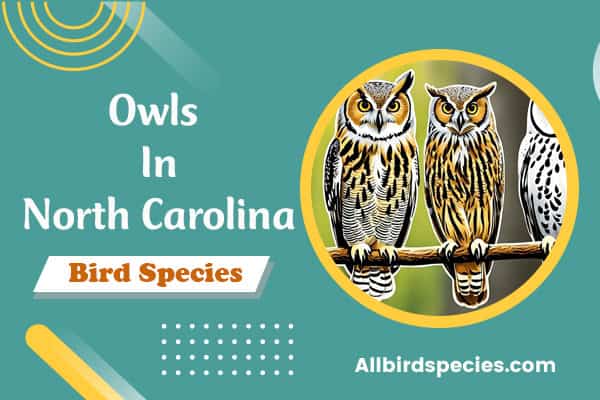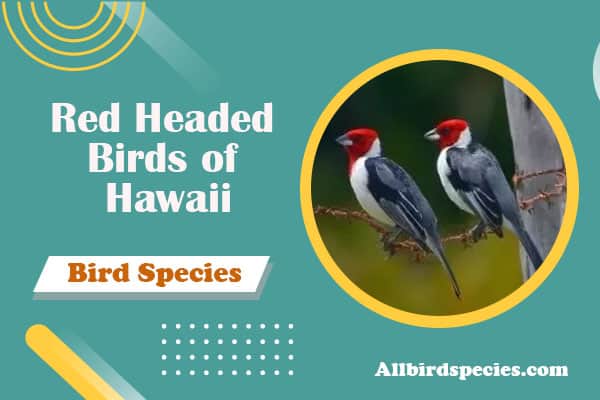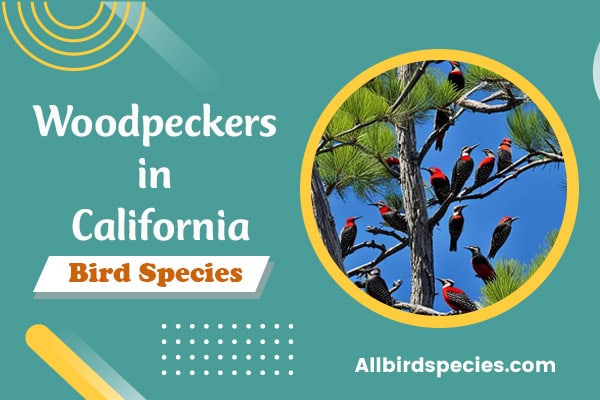6 Types of Owls Species in North Carolina (With Pictures)
Did you know North Carolina is home to over a dozen owls? These birds are key to our ecosystem, helping to keep it balanced. They act as both predators and signs of how healthy our environment is. In this article, we’ll look at six owl species found in North Carolina. We’ll highlight their unique traits and behaviors, and share beautiful pictures to help us appreciate these amazing birds more.
From the Great Horned Owl to the Northern Saw-whet Owl, each species adds to North Carolina’s wildlife diversity. Let’s start this journey to learn more about the fascinating world of owls in North Carolina.
Common Owls in North Carolina
- Eastern Screech-Owl
- Great Horned Owl
- Barred Owl
- Short-eared Owl
- Northern Saw-whet Owl
- American Barn Owl
1. Great Horned Owl
- Scientific name: Bubo virginianus
- Life span: 25 – 50 years
- Size: 43 to 64 cm (17 to 25 in)
- Weight: 1200 to 1600 g (2.64 to 3.52 lbs)
- Wingspan: 91 to 153 cm (3ft 0in to 5ft 0in)
The Great Horned Owl, known as Bubo virginianus, is a top predator in North Carolina’s wildlife. It’s known for its horn-like tufts and large size. Bird watchers and nature lovers find it fascinating.
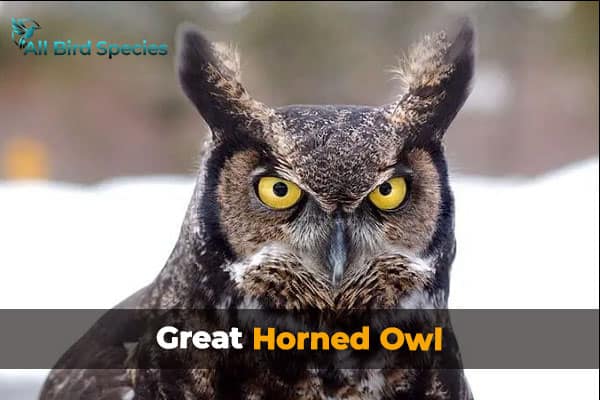
Description and Identification
This owl can be 43 to 64 cm long and weighs 1200 to 1600 g. It has bright yellow eyes and mottled brown feathers. These feathers help it blend in with its surroundings.
Habitat and Range in North Carolina
The Great Horned Owl lives in many places, from forests to cities. It’s found all over North Carolina. This lets us see it in different places and learn about local wildlife.
Diet and Hunting Behavior
Great Horned Owls eat rodents, rabbits, and even smaller birds. They hunt at night, flying silently and listening carefully. This way, they surprise their prey. Their hunting skills make them top predators.
2. Barred Owl
- Scientific name: Strix varia
- Life span: 8 years
- Size: 40 to 63 cm (15 to 25 in)
- Weight: 610 to 1,150 g (1.34 to 2.54 lb)
- Wingspan: 96 to 125 cm (38 to 49 in)
The Barred Owl, known as Strix varia, is a well-known bird in North Carolina’s forests. We find their looks and behaviors fascinating. They stand out in the woods with their unique traits.
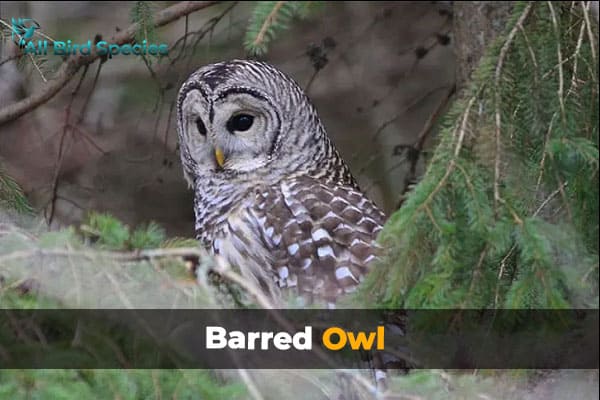
Physical Characteristics
Barred Owls are medium-sized birds with brown and white feathers. They range from 40 to 63 cm long and weigh 610 to 1,150 g. Their round faces and dark eyes make them easy to spot in the trees.
Preferred Habitats
These owls live in dense forests near swamps and rivers. They nest in large tree cavities. They like quiet woods close to water, making North Carolina perfect for them.
Vocalizations and Communication
Barred Owls make unique sounds to talk to each other. Their call, “who cooks for you,” is heard in the woods. This call helps them mark their territory and find mates in January. It tells us about their social life in the forest.
| Physical Characteristics | Habitat | Vocalizations |
|---|---|---|
| Medium-sized (40-63 cm) | Dense forests, swamps | Distinctive “who cooks for you” call |
| Brown and white barring | Large tree cavities for nesting | Communication for mating and territory |
3. Barn Owl
The Barn Owl, known as Tyto alba, is a standout among agricultural owls. It has unique features and adaptations. These owls have heart-shaped facial discs and long wings, measuring 34 to 43 cm wide and weighing 206 to 475 g. Their elegant look makes them a common sight in rural areas, where they hunt small mammals.

Unique Features
These owls are often seen in agricultural fields, using the open spaces to find prey. Their excellent hearing and silent flight help them hunt successfully. They mainly eat rodents, which helps farmers by controlling pests. Their striking looks and important role in nature make them popular with bird lovers.
Nesting Habits
Barn Owls like to nest in human-made places like barns and silos. These spots offer protection and are close to their hunting areas. They start breeding in winter, with females laying up to 12 eggs at a time. Their ability to adapt to farm environments helps them survive and reproduce.
| Feature | Description |
|---|---|
| Wingspan | 34 to 43 cm |
| Weight | 206 to 475 g |
| Common Habitat | Agricultural fields and rural areas |
| Nesting Sites | Human-made structures (barns, silos) |
| Diet | Small mammals, particularly rodents |
4. Eastern Screech Owl
- Scientific name: Megascops asio
- Life span: 8 to 10 years
- Size: 16 to 25 cm (6.5 to 10 in)
- Weight: 121 to 244 g (4.25 to 8.5 oz)
- Wingspan: 46 to 61 cm (18 to 24 in)
The Eastern Screech Owl, known as Megascops asio, is a fascinating and adaptable species. It thrives in many environments. Its ability to blend in and its unique nesting habits make it stand out in North Carolina. This small owl has remarkable traits that help it live in cities, suburbs, and rural areas.

Variations in Plumage
The Eastern Screech Owl has a range of colors, from gray to reddish-brown. This color helps it hide from predators and improves its hunting. They are small, measuring 16 to 25 cm tall and weighing 121 to 244 g. This size lets them fit into tree cavities and hidden spots.
Common Locations in North Carolina
In North Carolina, these owls nest in woodlands, suburbs, and parks. They like tree cavities and will use human-made boxes too. Their ability to adapt makes them common sights for those who love owls.
| Characteristic | Details |
|---|---|
| Scientific Name | Megascops asio |
| Size | 16 to 25 cm |
| Weight | 121 to 244 g |
| Color Variations | Gray to reddish-brown |
| Primary Habitats | Woodlands, suburban areas, parks |
| Nesting Preferences | Tree cavities, human-provided boxes |
5. Northern Saw-whet Owl
- Scientific name: Aegolius acadicus
- Life span: 7 to 17 years
- Size: 17 to 22 cm (6.7 to 8.7 in)
- Weight: 54 to 151 g (1.9 to 5.3 oz)
- Wingspan: 42 to 56.3 cm (16.5 to 22.2 in)
The Northern Saw-whet Owl, known as Aegolius acadicus, is a mysterious bird in our local owl population. It has a small size and blends into the forest with its unique look. Learning about its size, appearance, and how it breeds helps us understand its importance in nature.
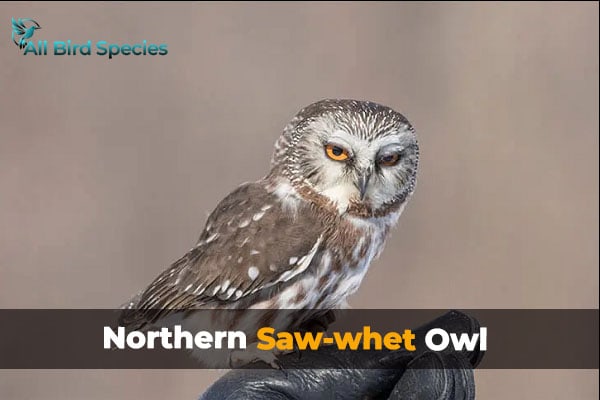
Size and Appearance
This owl is between 17 to 22 cm long and weighs 54 to 151 grams. It has a small, sturdy body with brown and white patterns that help it hide in trees. Its big, round head and bright yellow eyes make it stand out when we see it in the wild.
Breeding Habits
In spring, the Northern Saw-whet Owl starts breeding in high places among spruce-fir trees. They make a sound like a saw being sharpened during courtship. This sound is often heard at night. Seeing these owls during breeding is rare, which makes them even more fascinating.
6. Short-eared Owl
- Scientific name: Asio flammeus
- Life span: 12 years
- Size: 34 to 43 cm (13 to 17 in)
- Weight: 206 to 475 g (7.3 to 16.8 oz)
- Wingspan: 85 to 110 cm (33 to 43 in)
The Short-eared Owl, known as Asio flammeus, stands out with its unique traits and behaviors. It’s a small bird, measuring 34 to 43 cm long and weighing 206 to 475 g. It’s easy to spot because of its small ear tufts and bright yellow eyes. These owls love to fly over open areas, which is where they hunt and nest.
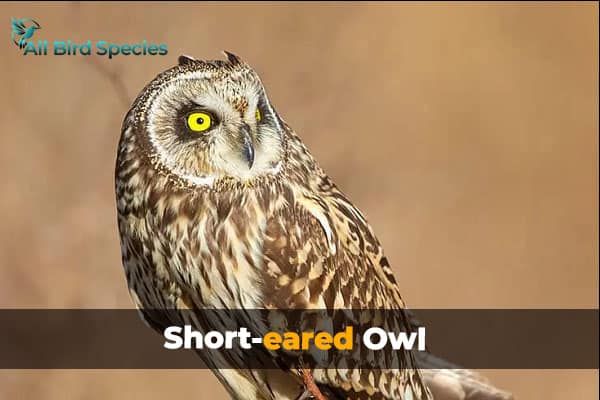
Identification and Behavior
What’s fascinating about the Short-eared Owl is how it nests on the ground. Unlike many owls, it builds its nest right on the ground, hidden under grasses or low plants. This makes it easy prey for other animals, but it also lets the owl get to food quickly in places like grasslands.
These owls are most active during twilight, the best time to catch food. Watching them, we see how adaptable and skilled they are at controlling rodent populations.
Diet and Feeding Techniques
The Short-eared Owl eats mostly small mammals, with voles being a big part of its diet. This shows how important they are in keeping the ecosystem balanced. They use their great hearing and sight to find prey, even in the dark. Their hunting style is unique, hovering and then swooping down to catch their prey with precision.
Owls in other Regions:
Owls in North Carolina: Their Role in the Ecosystem
Owls play a big part in North Carolina’s ecosystem. They are top predators that keep the balance by controlling small mammals and other prey. This balance is key to a healthy ecosystem, showing how important owls are to our local environment.
Significance of Owls in Biodiversity
Owls are crucial for North Carolina’s biodiversity. They keep rodents and insects in check, preventing any one species from taking over. This balance is essential for the survival of many plant and animal species. When owls do well, our ecosystems become healthier, supporting a wide variety of life.
Interaction with Other Wildlife
Owls affect many other species in North Carolina. They hunt skillfully, changing the behavior and numbers of their prey. This interaction leads to a balanced environment where different species can live together. Knowing about these relationships helps us protect owls and the many species they live with.
Conservation Challenges for Owls
Owls in North Carolina face many challenges that threaten their survival. Human actions and environmental changes harm their homes. These are vital for their living and hunting. Knowing these threats helps us protect them better.
Threats to Habitat and Nesting Sites
Urban growth, farming, and climate change hurt owl habitats in North Carolina. Owls need certain places for nesting and hunting. But, as these places change or get destroyed, owls find it hard to survive. The main threats are:
- Deforestation and habitat fragmentation from land development.
- Pesticide use that affects their food.
- Changes in land use that remove important nesting sites.
- Climate change that changes their food and nesting conditions.
Conservation Efforts in North Carolina
There are efforts to fight these threats and protect owls in North Carolina. These include:
- Habitat restoration projects that help native plants grow.
- Protecting important nesting areas with laws.
- Community programs to teach people about owl conservation.
- Watching owl populations to understand their health and make smart choices.
Engaging with Owls: How We Can Help
Getting involved in owl watching and conservation lets us connect with nature. By learning owl-watching tips and helping with local conservation, we can protect these amazing birds.
Tips for Owl Watching
When we go to watch owls, it’s important to respect their space. Here are some tips to make our experience better:
- Choose places known for owl activity, like during dusk or dawn.
- Use binoculars to see them from far away without disturbing them.
- Be quiet and move slowly to not scare the birds.
- Look at nesting sites from a distance, without going near.
- Share what you see to help with science projects.
Participating in Local Conservation Efforts
Helping with local conservation efforts keeps owl populations healthy. Here’s how we can help:
- Join groups that work on restoring habitats for wildlife.
- Take part in programs that teach people about owl conservation.
- Help out at owl festivals or workshops.
- Support laws that protect nature.
- Use social media to spread the word about protecting owls.
By following these tips and helping with conservation, we can help owls and their homes in North Carolina. Together, we can appreciate wildlife more and benefit everyone.
Myths and Facts About Owls
We often hear owl myths that cloud our view of these fascinating birds. From their unique looks to their habits, many misconceptions hide their true nature. Here, we’ll clear up common misunderstandings and share interesting facts about owls and their ways.
Common Misunderstandings
Many believe owls can see in total darkness, which isn’t true. Owls have great night vision but need some light to hunt well. Also, it’s thought owls live alone. But, some species are social, especially when breeding or living in certain places.
Understanding these myths helps us appreciate owls more.
Interesting Facts About Owl Behavior
Owls are fascinating with behaviors that show their smarts and adaptability. For example, owls can turn their heads up to 270 degrees. This lets them look around without moving their whole body. They also have special feathers that help them fly quietly, which is great for hunting.
This shows how owls play a key role in keeping pests down and supporting nature.
| Owl Myth | Fact About Owls |
|---|---|
| Owls can see in complete darkness | Owls need some light to hunt, but they have amazing night vision. |
| Owls are always solitary | Some owl species live together, especially when they’re breeding. |
| All owls hoot | Owls make different sounds, not just hoots, to talk to each other. |
| Owls are a sign of bad luck | In many cultures, owls are seen as symbols of wisdom and protection. |
Wrapping Up…
We’ve looked into the world of owls in North Carolina and found it fascinating. From the Great Horned Owl to the Northern Saw-whet Owl, each species is crucial in our ecosystems. They are key predators that help keep our ecosystems balanced.
Owls face big challenges like losing their homes and places to nest. We need to protect their habitats so they can keep living in North Carolina. By helping with conservation, we can keep our wildlife diverse and our ecosystem healthy.

